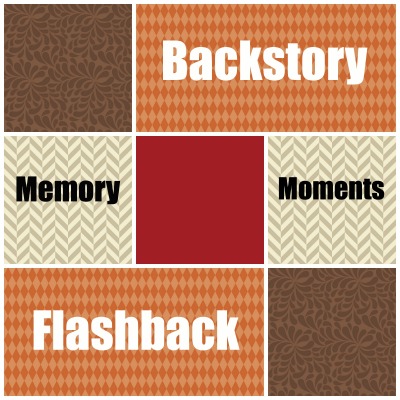In order to give our characters depth and widen our stories, we layer in backstory, flashback and memory moments.
Flashbacks and Backstory are familiar terms to most novelists.
Memory moments is my term to break out from backstory and flashback as ways to bring in “the past” of a character.
I also use the term Character History. But I’ve blogged about that already and it’s not exactly where I’m going with this post.
This post is the difference between backstory, flashback, and memory moment.
Backstory is back story. Another story. Something from the character’s “past.”
The rule in novel writing is no back story for the first 30 – 50 pages. Meaning, no wandering backwards in the character’s story line while we’re meeting them and discovering the initial conflict.
But we never really need a break from the current action to go backwards in the story.
What we need is enough of their story from the past that show’s motivation. I call this character history.
Backstory should only be delivered in small prose sentences or in dialog. The preferred way is dialog.
What does backstory do? What’s the purpose? To deepen emotion. To show motivation. To let the reader get inside the heart and mind of the character.
Backstory adds shades and textures.
If you find you’re writing more than two to four sentences of backstory, you’re going down a dark place. 🙂
You’re leading the reader into another story!
So maybe what you’re trying is a flashback. You want to tell another story, another part of your character’s life.
Flashbacks go back in time. They tell another story.
They must support the main plot.
The Divine Secrets of the Ya-Ya Sisterhood uses flashbacks to tell the beginning of the sisterhood and the childhood of the protagonists.
I used flashbacks to tell the youth and teenage hood of Jade Fitzgerald Benson in the Songbird Novels.
These flashbacks are a sub plot. They triggered off of something happening in the current life of the heroine, Jade, that caused a memory.
I clearly entered the flashbacks. I clearly exited those scenes. I didn’t meander into them.
So if you are using flashbacks to tell your story, make sure it ties into the main story but has it’s own arc.
Memory moments are the most common thing we use to generate connection and emotion with the character.
These are moment in prose or dialog (always the preferred method) of revealing the heart and memories of the characters.
It’s a great way to build connection between hero and heroine.
Where they have a tender moment reminiscing, having a vulnerable moment, where they share their hearts, a treasured memory.
This causes them to deepen their feelings and connection, thus their romance.
So how do you choose what you need for your novel?
Backstory? Sparingly and spread evenly through the middle of the book. Act 2. Backstory is largely for you, the author, to know how to steer and guide current, onstage motivation.
Backstory is the story that the protagonist is dealing with in your story. It’s WHY you’re telling this story. Use dialog as often as possible to delver back story.
Flashbacks is another story from another time. Do you have a sub plot from the character’s past that needs telling? Does it enhance the story? Use scenes, setting, dialog, goals to set flashbacks.
Memory Moments are you best option. Sharing the past, special moments, dark wounds or secrets with other characters. Use dialog and metaphor to show these moments.
Think about what you’re doing. All of these are effective. But use what’s best for you story!
***
 Best-selling, award-winning author Rachel Hauck loves a great story. She excels in seeing the deeper layers of a story.
Best-selling, award-winning author Rachel Hauck loves a great story. She excels in seeing the deeper layers of a story.
With a love for teaching and mentoring, Rachel comes alongside writers to help them craft their novel. A worship leader, board member of ACFW and popular writing teacher, Rachel is the author of over 17 novels. She lives in Florida with her husband and dog.
Contact her at: Rachel@mybooktherapy.com. Pre order her next release, Princess Ever After, book two in the Royal Wedding Series.
Do you need help with your story idea, synopsis or proposal?How about some one-on-one craft coaching. Check out our menu of services designed to help you advance your writing dreams.
